Written aboard the Longship Odin on her river voyage with stops in Paris, Luxembourg, Trier, Cochem, Heidelberg, Wurzburg, Rothenburg, Nuremberg and Prague. Thanks to Viking River Cruises for inviting us along and providing this adventure! As always, all opinions are our own.
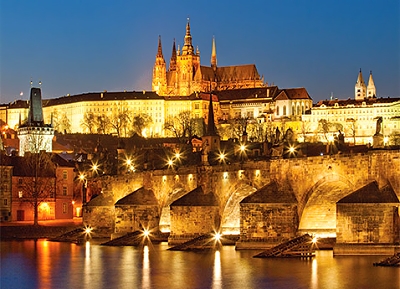
We’re excited to bring you along LIVE as we explore the cities of light along the Rhine, Moselle and Main Rivers!
We’ll be cruisin’ through France, Luxembourg, Germany, and the Czech Republic with stays in two of Europe’s most glorious cities, Paris and Prague.
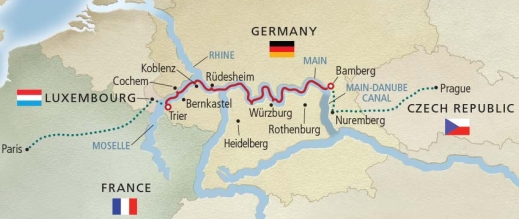
Day One: Paris!
Afternoon: We make a beeline for the Eiffel Tower
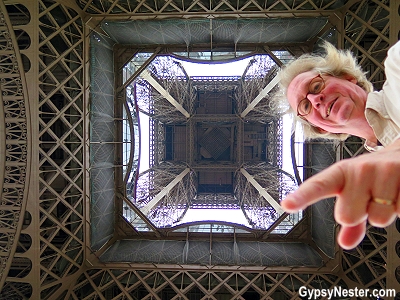
When Gustave Eiffel designed and built his tower in 1889 as an entrance to the 1889 World’s Fair he probably had no idea that it would become the enduring symbol of the city of Paris.
Seems like the perfect first stop for our visit to the City of Light.
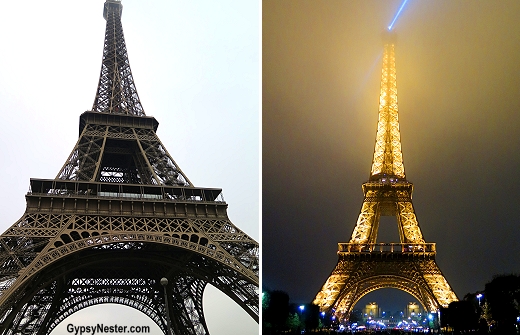
Once the tallest man-made structure on earth, the Eiffel Tower stands over a thousand feet high, but we were content to climb to the second observation level, just over a third of the way up. Even through the fog the panoramic view of the city was spectacular.
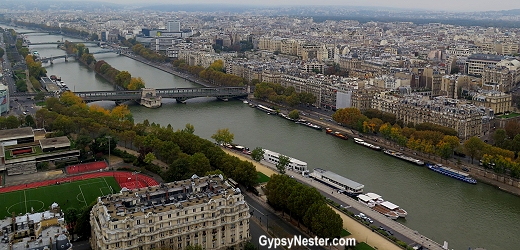
See more photos of our antics at the Eiffel Tower!
Evening: Notre Dame c’est magnifique!
While the Notre-Dame Cathedral might be best known to us Americans for its bells — and a certain odd little man who rang them — the gargoyles, rose window, and flying buttresses are what are most catching our attention.
Built over the course of nearly two hundred years, beginning in 1163, Notre-Dame de Paris was among the first buildings in the world to incorporate the flying buttress as reinforcements for the walls. Although they were not part of the original design, its size required the additional support.
In the several hours we spend observing the church from every possible angle, and then while we hang around in the nearby Latin Quarter, we hear the bells toll several times.
No idea who has the honor of ringing them though.
Check out more about Notre Dame Cathedral
Night: Triumphantly conquering the Arc!
10 Second video: Click the pic – and the crazy traffic comes
to life!
Next to the Eiffel Tower, the Arc de Triomphe may be the most recognizable monument in Paris.
The insane traffic clogging the roundabout that encircles the arch makes it look as though it might be impossible to get to.
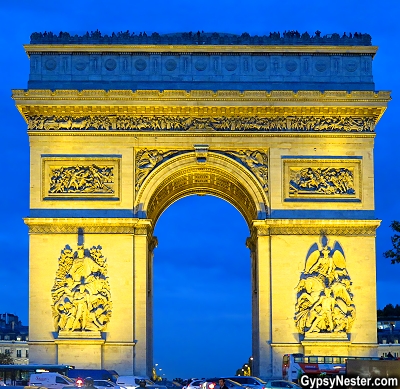
Luckily there is a tunnel underneath the street that makes passage possible without risking our lives.
Built in 1806 to commemorate the victory at Austerlitz by Emperor Napoleon, the massive arch has gained significance as a memorial for all of the wars since and houses the tomb of the Unknown Soldier.
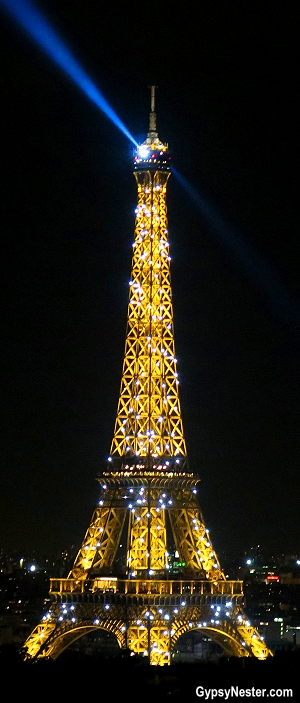
We exit the tunnel just in time to see the changing of the guard at the tomb.
Impressive as the perspective is from the ground, we are most excited to climb to the top for the ultimate view of the city.
A few hundred steps later and a full 360 degree panorama of Paris is spread out before us just as darkness is falling.
The vantage point is unbeatable, not only for photographing Gustave Eiffel’s handiwork, but observing the continuous chaos on the roads below.
The flow of vehicles begins to look as if it is a living organism coursing through the arteries of the city.
Take a peek inside the Arc de Triomphe
See our antics at the Eiffel Tower and learn a few things about her that you didn’t know!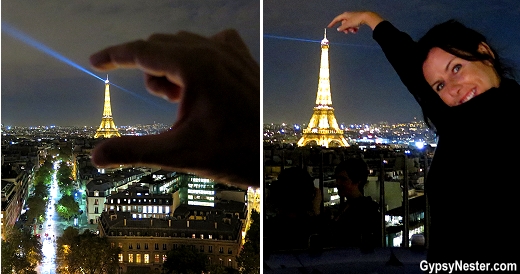
| For a final treat before we descend, the moon peeks out of the clouds just as the twinkling lights come to life on the Tour Eiffel.
Magnifique! <–10 Second video: Click the pic – and be dazzled! We haven’t taken our jet-lag into account yet — due to excitement — but we’d better head to our hotel before we collapse! |
See all of our adventures in Paris!
Day Two: Creepy Catacombs and the Amazing Art and Architecture of Paris
Morning: Mon Dieu! Down deep into Paris
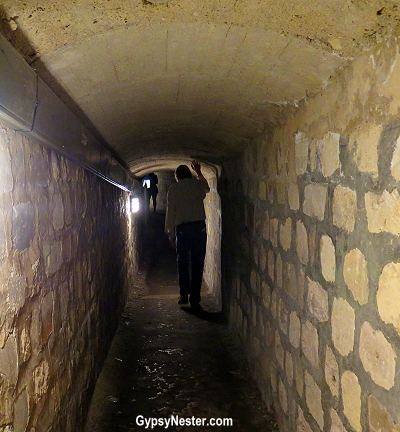
As far as we can tell, Halloween isn’t celebrated much in Paris, so we found a way to scare ourselves silly and dig our way deep into Paris.
There is a surprisingly long line to enter the Catacombes de Paris, but the underground adventure turns out to be more than worth the wait.
These tunnels and excavations were originally dug as a limestone quarry to supply building material for the world above. Years later, when several of the city’s cemeteries ran out of room for any more burials, the remains of some six million people were moved into the Catacombs.
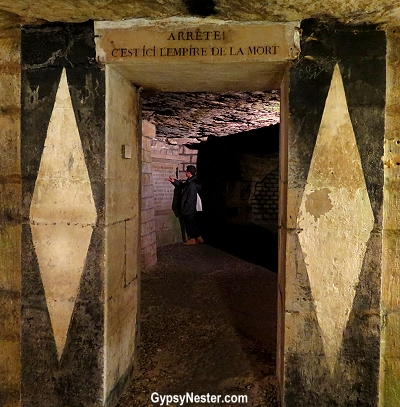
Over time this became known as The World’s Largest Grave and began to attract curious visitors, including King Charles X, and was quite an attraction at the 1900 World’s Fair Exposition.
We proceed past the warning, Stop! This is the Empire of Death, and enter to see for ourselves.
What we find is beyond extraordinary, it’s downright bizarre, and the Halloween timing of our visit makes us just a little jumpy.
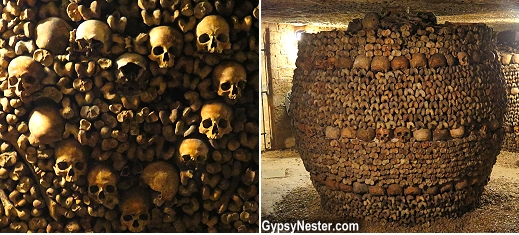
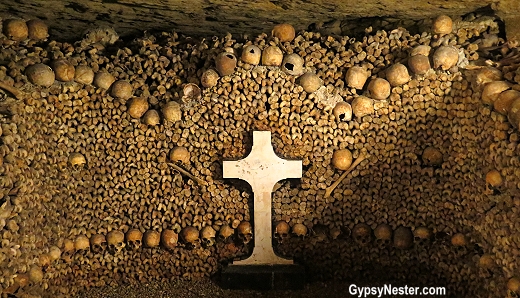
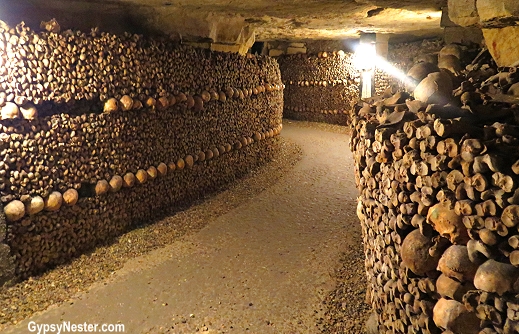
Head deep inside the Catacombes de Paris for more
Afternoon: Just LOOK at these buildings!
As part of our Viking cruise we set out on a bus tour of Paris for a peek at some of the city’s preeminent landmarks. A quick spin through the roundabout encircling the Arc de Triomphe gives us a great view of the monument, plus a taste for the crazy traffic that fights its way between the twelve streets that connect here.
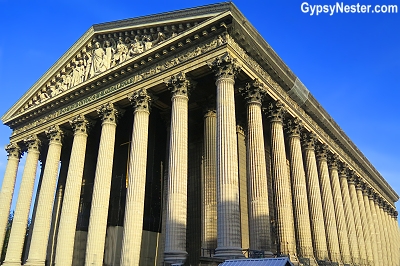
Nearby, La Madeleine looks much more like a Roman temple than a church. In fact, The Madeleine Church was built as a temple to the glory of Napoleon’s army in 1806.
Years later, King Louis XVIII decided that the building should be used as a church, and dedicated it to Mary Magdalene.
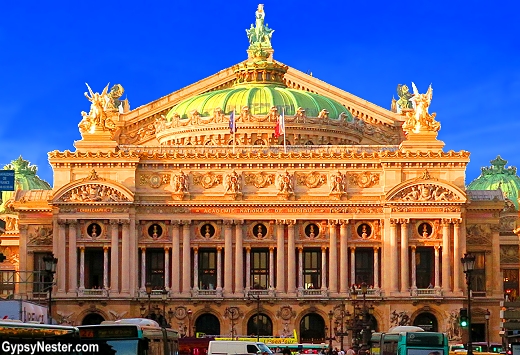
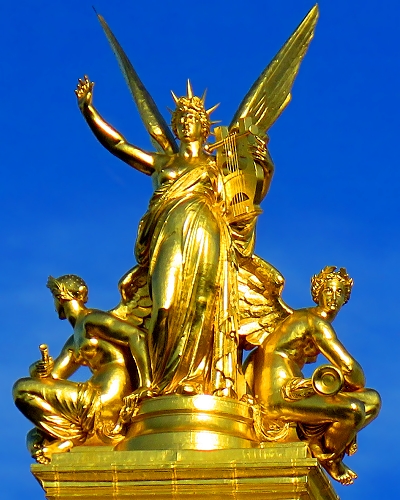
Next we pass the Palais Garnier, generally known as the Opéra de Paris, or Paris Opera House.
We know it as the home to the Phantom of the Opera, but that is only a small part of why this may be the most famous opera house in the world.
The amazing architecture could be more responsible for that stature.
<– This statue is atop the building (see left corner of the pic above)!
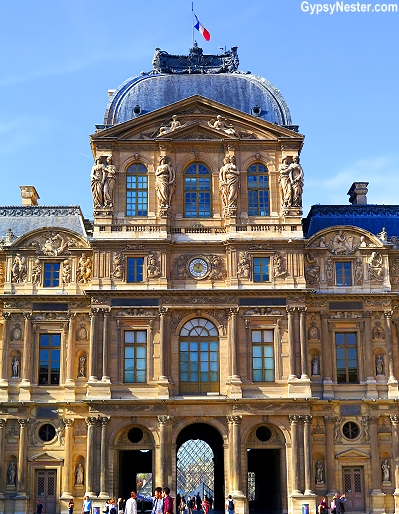
We do a drive-by through the courtyard of the Louvre, where it is easy to see how it was originally built as the Louvre Palace over eight hundred years ago.
When Louis XIV chose to move to the Palace of Versailles in 1682, the Louvre became a place to display the royal collection, including an impressive array of ancient Greek and Roman sculpture.
If not for the fact that we are coming back later, we would jump out and run inside.
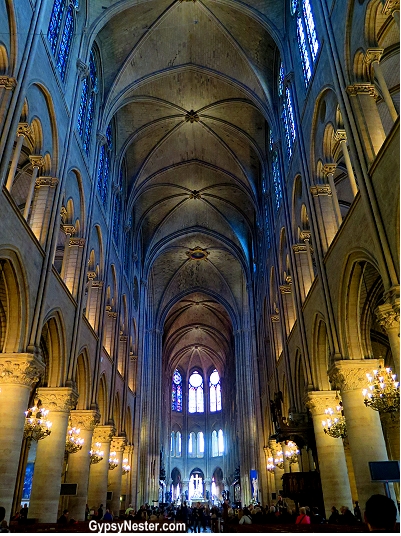
Speaking of inside, we do get to go in the Notre Dame Cathedral, and it is every bit as amazing as we expected.
Our guide offers an amusing warning about pickpockets, saying that it is the perfect spot for these thieves because of the darkness and the availability of immediate confessions in twelve different languages.
The sunlight streaming through the stained glass rose windows lit the otherwise darkened sanctuary in muted colors and makes us feel perfectly safe.
No nefarious characters in sight, hunchbacked or otherwise.
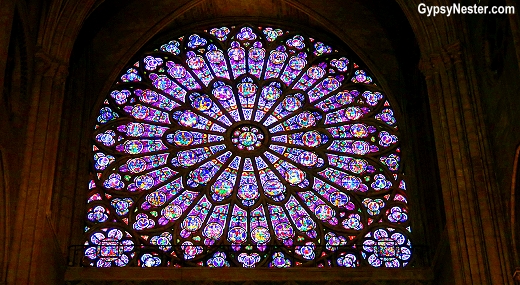
A quick stop for some macaroons gives us the energy to walk along the Seine back to the Louvre and a visit with a couple of grand ladies, Mona Lisa and Venus de Milo.
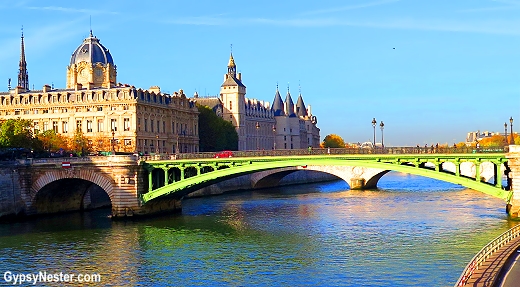
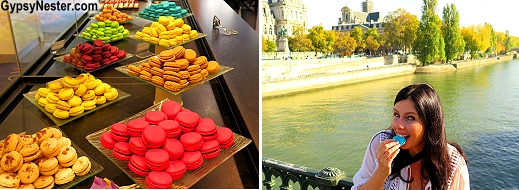
Evening: Loving the Louvre!
It would be impossible to see the collection at the Louvre in one afternoon, so our plan is to hit the highlights.
The former royal palace is home to an array of works that even uninformed art aficionados such as ourselves recognize immediately.
We are surprised to discover that a spot right near the entrance marked “New Acquisition” has been made ready for Veronica’s napkin masterpiece cover art sketch of Going Gypsy.
Unfortunately, we only have an iPad (new media?) copy with us. The original is being held for safe keeping at Skyhorse Publishing, just in case it becomes really valuable, or pigs start flying, whichever comes first.
From that coveted position we make our way to the sculptures of ancient Greece, many of which strike us as downright bizarre. A few of our favorites are…
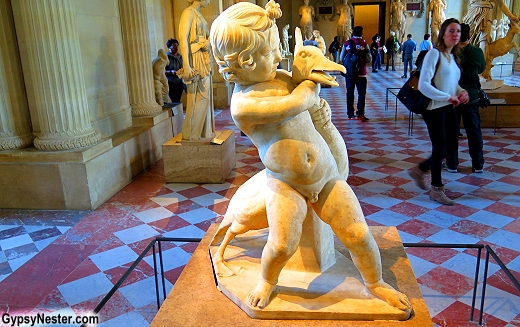 Boy Delivering Severe Beat-down to Goose…
Boy Delivering Severe Beat-down to Goose…
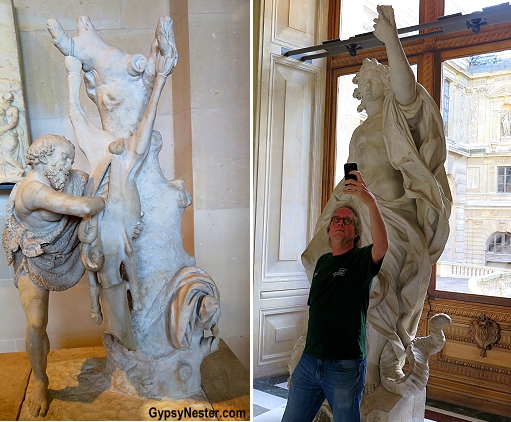
Man Pulling Guts Out of Animal… Ancient Greek Dude Taking a Selfie…
…and Supine Woman With Shocking Surprise on the Front Side (turns out she’s just one of the boys!).
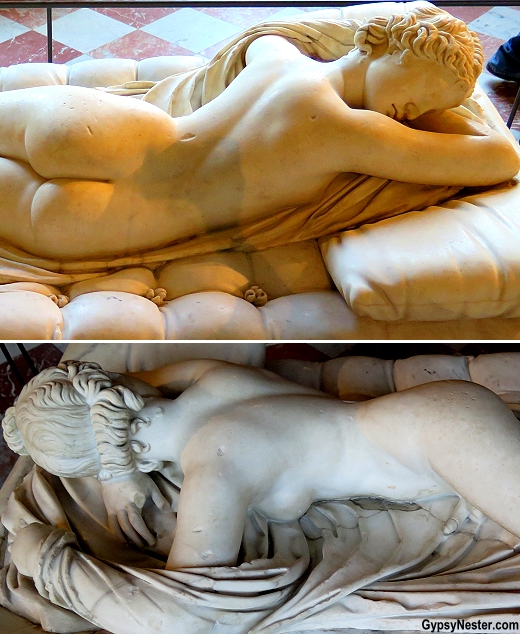
Guess what, these are not the actual names. Truth is, these are all remarkable, masterfully sculpted works of art.
Heretofore we shall endeavor to display a modicum of proper decorum. The sight of Venus de Milo snaps us back to a state of appropriate awe.
<– Here’s what Venus de Milo sees
Named for the Greek Isle Milos, where it was discovered in 1820, she is Aphrodite, goddess of love and was sculpted over one hundred years before the time of Christ. She is considered a classic example of ancient Greek sculpture and, despite her loss of limbs, looks mighty good for her age.
Leaving the marble masterpieces behind, we head to the gallery of Italian artists.
Here we shall find Leonardo da Vinci’s most famous work, Mona Lisa.
Perhaps her appearance in the background of countless tourist selfies is what is keeping her smiling these days.
Want to see our full collection of odd art at the Louvre?
See all of our adventures in Paris!
Day Three: Four Countries in One Day
Morning: Bidding Adeau to France
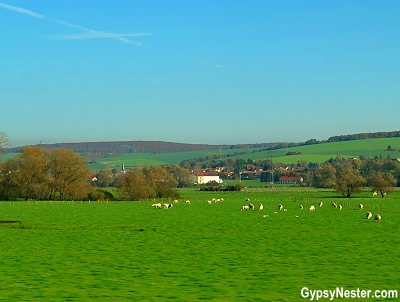
Today begins with a ride across the rolling hills and fields of France, the first of four countries we will set foot in today on our way to our Viking ship Odin.
With the Champagne region, famous for obvious reasons, rolling by our window autumn is on display much more than back in the big city.
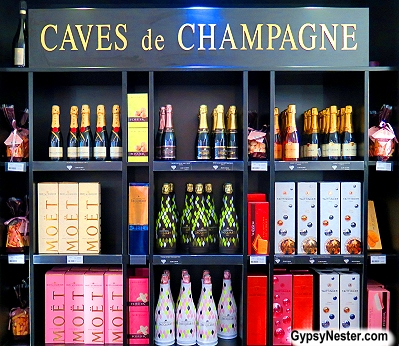 <
<
Nearing the end of our time in France we pass through the region of Lorraine, which is known for the egg dish that our program director Radim called a salty pie… quiche.
Afternoon: Luxurious Luxembourg
We stop in the Grand Duchy of Luxembourg, the world’s last remaining grand duchy, meaning that it is headed by a grand duke.
Taking a wild guess, we say that its survival has a lot to do with the fortifications we pass entering Luxembourg City.
Inside the walls we get a glimpse of what life looked like centuries ago.
Space was at a premium within the ramparts, so the streets were narrow and homes crowded together.
An arch displays crossed arrows above the doorway, a superstition utilized for plague avoiding. The idea was that since the sores from the dreaded disease looked like arrow wounds, perhaps this symbol might keep it away.
Standing on what is called the most beautiful balcony in Europe, it is easy to see why this was once called the Gibraltar of the North. The city was built with nearly perfect natural protection on three sides.
Slightly smaller than Rhode Island, Luxembourg is one of the smallest countries in Europe and is surrounded by France, Belgium, and Germany.
This has made for an interesting mixture of languages, with official business being conducted in three, Luxembourgish, French, and German.
As far as day-to-day life on the streets goes, we hear dozens of languages, often several used within the same conversation.
See more about fantastic Luxembourg!
Evening: An All Saints Day visit to our fallen
Just outside the city we visit the the solemn ground of the Luxembourg American Cemetery and Memorial, which is technically American soil, therefore entering our third country of the day.
Luxembourg presented the land to the United States in perpetuity in appreciation for being freed from Nazi occupation.
Many of the soldiers who lost their lives at the nearby Battle of the Bulge, which was instrumental in ending World War II, are buried here.
General George S. Patton, who survived the battle but perished in an automobile accident a few months later, is also laid to rest here.
See more about our visit to the Luxembourg American Cemetery
Hello Odin!
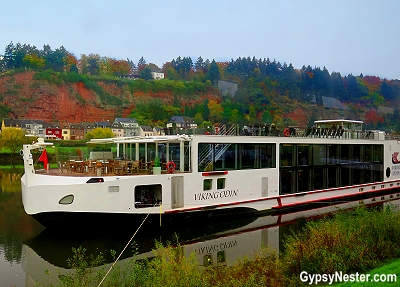
Crossing one more border, making for our fourth nation in one day, we finish the day in Germany’s oldest city, Trier.
Our home for the next week, the Viking Longship Odin, waits docked on the Moselle River.
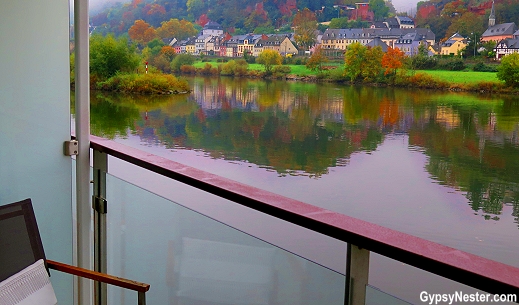
The view from our balcony!
WATCH: Our hotel manager, Thomas, shows us around our stateroom!
Day Four: Ancient Germany, Wine Country, and Sausage Walking
Morning: The oldest town in Germany
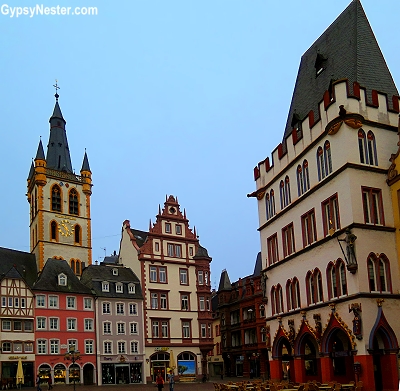
We awake from our first night aboard the Odin ready for a tour of Trier, known as the oldest city in Germany.
Established by the Romans over 2000 years ago as Augusta Treverorum, the city is certifiably ancient, however it has only been a part of Germany for the last two hundred of those years. For more than a thousand years in between it was ruled by the Franks.
As the largest Roman city north of the Alps, Trier was extremely important, and much of the Roman history is well preserved. On our way to the main square, we pass the Roman Bridge over the Moselle River, two cranes along the banks, parts of the original city walls, an amphitheater, and a large section of ruins from the Roman baths. All, we are told, are the oldest in Germany.
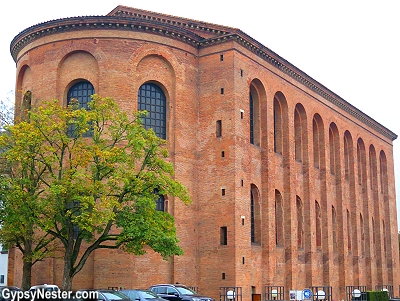
The modern city is still centered around the Palace Basilica that Emperor Constantine built in the year 310, making it another oldest in Germany.
It is an amazing piece of preserved Roman architecture, with the brick work still in remarkable condition. As with so many Roman structures, it became a church, and also served as the residence for the bishop…
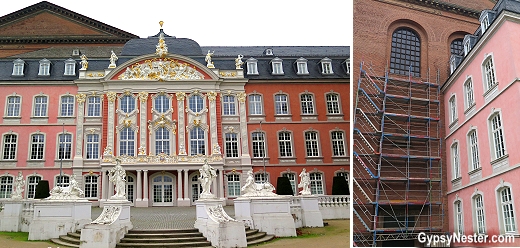
until a more proper palace connected to the front was constructed in the seventeenth century.
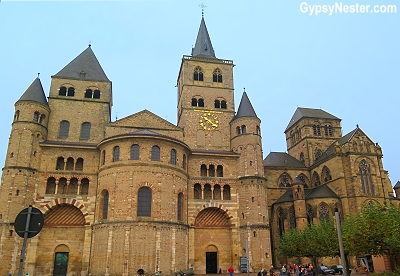
The Liebfrauenkirche (Church of Our Lady) holds the title of the oldest Gothic church in Germany, while next to it, the even older High Cathedral of Saint Peter is the oldest church of any kind in the country.
The cathedral was constructed using the bricks and stones from the even older Roman ruins beneath it.
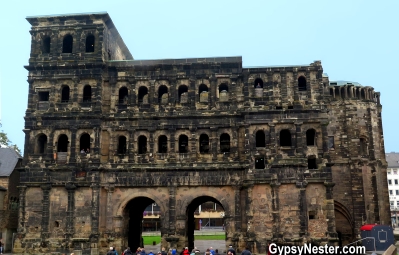
Perhaps Trier’s most famous landmark is the Porta Nigra, or black gate, the only remaining of the four original passages through the defensive city walls that the Romans built around 200 AD.
About a thousand years ago it too was transformed into a church, then in 1804 Napoleon ordered it restored to its original Roman form. Oh, and there is no older Roman gate in Germany.
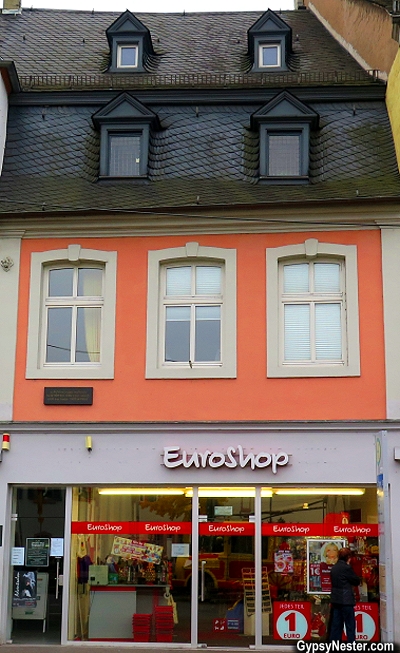
The “oldest in Germany” moniker became a bit of a running gag with our guide, Jens, as most anything notable was identified as the oldest in Germany.
So to recap, we saw the oldest bridge, crane, walls, baths, amphitheater, palace, churches, and Karl Marx house in Germany. Wait, what?
Oh yeah, Karl Marx was from Trier, and his house is right by the Porta Nigra. It is now a Euro Shop, or what we know as a dollar store.
Somehow we just don’t see the author of The Communist Manifesto shouting out, “price check on aisle 3,” before bursting into laughter because everything costs one Euro.
Afternoon: Cruising through the most beautiful wine country
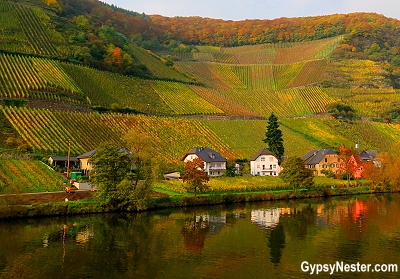
As we make our way down the Moselle we are cruising through one of Germany’s best known, and certainly most beautiful, wine regions.
Oh yeah, and the oldest too, because it was the Romans who first planted grapes here.
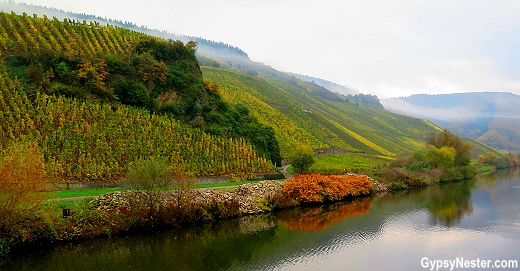
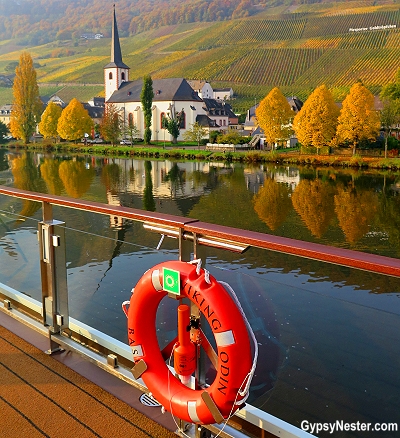
These picturesque hillsides produce wonderful Rieslings thanks to the sun on the south facing slopes, and perfect climate.
By now most of the vineyards have been harvested, but we do spot a group gathering grapes up one steep hillside.
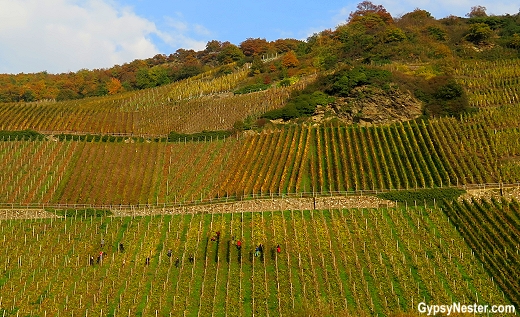
Evening: Upping the Riesling ante
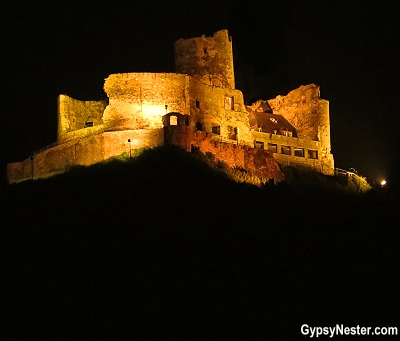
The charming medieval village of Bernkastel is our next stop.
We dock directly under Landshut Castle and disembark for an evening exploration. Our first mission, join the Executive Chef from our ship, Andreas Glashke, for a sampling of sausages from a riverside stand.
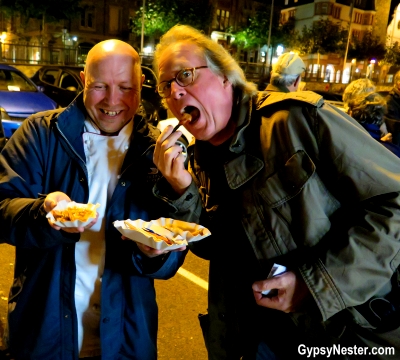
This “sausage walk” was a last minute surprise that we discover is added to the itinerary from time to time.
Generally, according to unnamed crew sources, whenever Chef Andreas gets a hankering for some sausage.
After a few bites of brats and currywürst we, and most of the rest of the passengers, were sure glad he did.
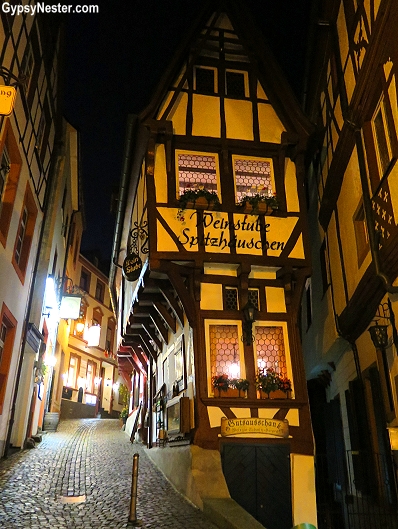
The distinctive buildings of the town, known as half-timber houses, look decidedly top heavy as they jut out and expand from the second floor up.
Many look to be leaning to and fro in a most precarious way.
The story we hear is that the design was developed to avoid taxes.
It seems that buildings were taxed based on the size of their ground floor, so the extended upstairs were basically tax free.
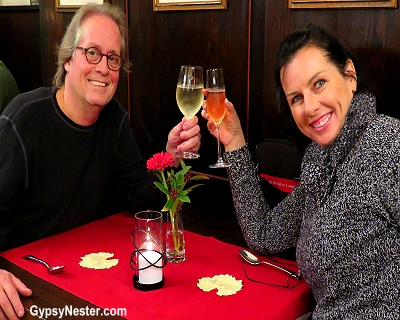
Veronica has hers laced with Weinbergspfirsichlikor,
a regional peach liquor
The area is all about the wines, but when we stop in a little gasthaus we discover that chanterelle mushrooms are nearly as big a deal in these parts.
So by all means, we must try the two together.
We order two reislings, one trocken (dry) and the other halbtrocken (half-dry), to go with two bowls of wild mushroom soup.
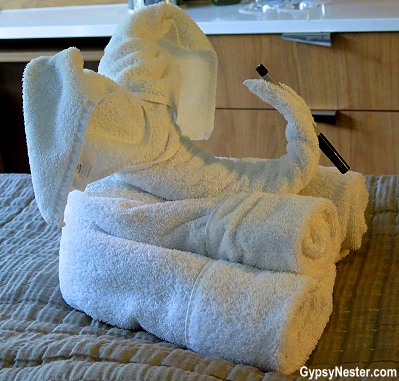
Back aboard the Odin we find our bed is occupied by an unexpected guest.
Who knew that elephants live in the Moselle valley?
Our cabin steward, Ionut, is happy to hear how much we like his addition to our collection of cruise towel animals and promises even better specimens to come.
We can hardly wait.
Day Five: The View from a Castle and Towel Animals Gone Awry
Morning: Storming the castle

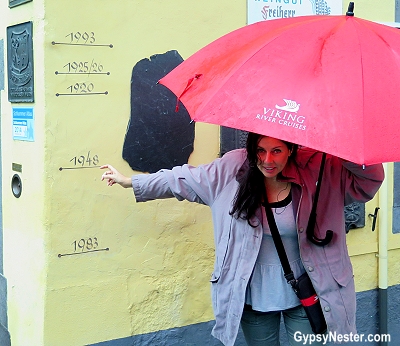
Our rainy day begins in Cochem, another town deeply connected to wine, and overseen by the imposing Imperial castle Reichsburg on the hill high above.
As we enter through the medieval city gate we see by the flood water markings that the city is also dominated by the Mosel River.
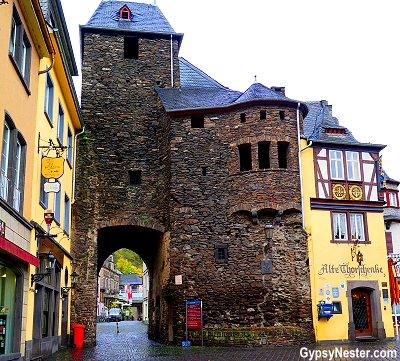
Inside the walls we find several wine presses on display, most real, but one odd statue of a goat in a press.
Our guide explains that legend has it that the goat was suspected of eating grapes, so the town judge decided to use the wine press to see if any wine would come out when the poor billy was squeezed.
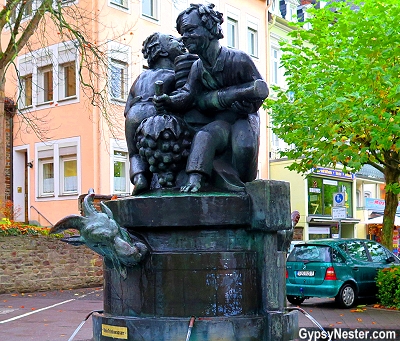
Nope, only blood, and since only white wines are produced in this region the now dead goat was pronounced innocent.
We must confess to some confusion as to why this story is worthy of being immortalized in statue form.
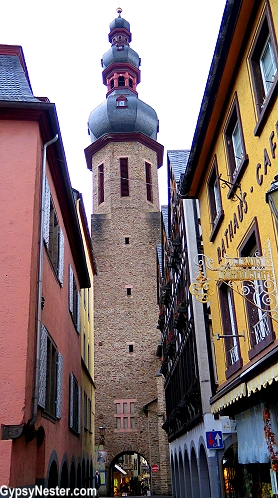
The bell tower of St. Martin’s Church, Martinskirche, overlooks the old town market, where the saint is also remembered with a fountain. But the highlight for us comes when a special performance of Handel is played on the bells of the optometrist’s building.
Yet another odd story, the bells were installed as a sarcastic gesture toward the city hall across the square. Three times a day the bells ring out, basically declaring “I built this in spite of your rules” to the town council.
All of this is only an appetizer for the main course, the Cochem Imperial castle, Reichsburg. Actually, saying Reichsburg castle is redundant, like saying Reichs castle castle, because burg means castle.
By any name it is a fantastic sight looming over the town. It is even more impressive inside. Originally built in 1130, what we see was reconstructed from ruins by a private businessman, Louis Ravené, about one hundred and fifty years ago.
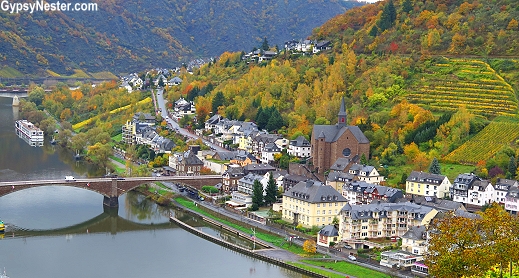
Afternoon: Enjoying Odin
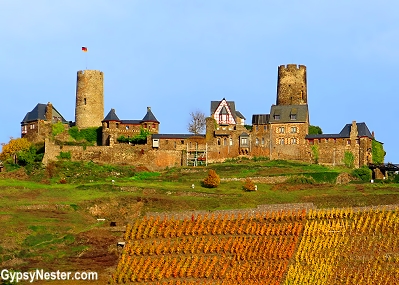
We spend the afternoon aboard the Odin, but there is no shortage of activities to keep us entertained. Chef Andreas shows us how to make bread pudding, and there are painting and German classes.
Of course, first and foremost there is the breathtaking scenery of vineyards, quaint towns, and ancient castles flowing past us at all times.
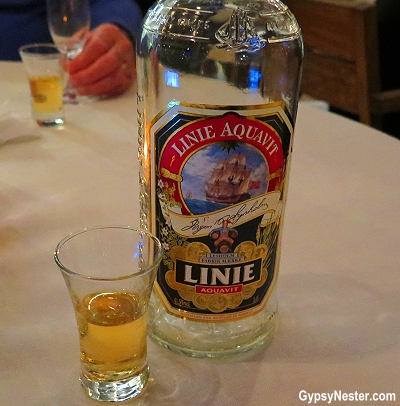
At the Viking Explorer Society cocktail party, where all veteran Viking sailors meet and greet with each other and the crew, our Hotel Manager, Thomas, introduces us to an age-old Norwegian tradition, Linje Aquavits.
Aquavits is a Scandinavian liquor similar to vodka, but aged in oak barrels.
To earn the Linje title the casks must be aboard a ship that crosses the equator (the Linje) at least twice. The rocking of the ship makes for a smooth flavor that just can’t be replicated on land.
Evening: Getting the ol’ blood pumping
Upon returning to our cabin we were given quite a start by opening the door to find someone in our bed – in the dark and watching CNN on our TV. Thinking we must be in the wrong room we sheepishly apologize and quickly shut the door.
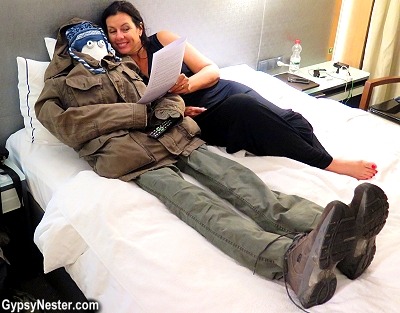
Is the Aquavits that strong?
No, we aren’t crazy or drunk, this is our room. Looking in again we discover that Ionut has raised the bar of cruise towel animals to a new high, moving into the realm of humans.
We must find a way to up the ante ourselves.
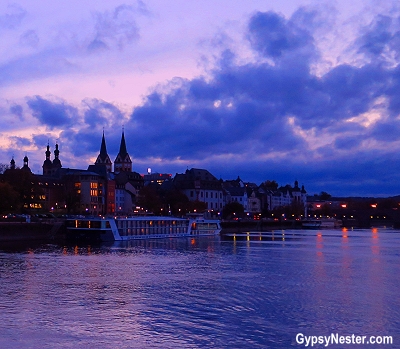
Just before sundown we arrive at Koblenz, where the Moselle River joins up with the Rhine.
After spending the night docked we will be sailing upstream along what is known as the Middle Rhine, or Romantic Rhine, with an incredible concentration of medieval castles unlike anywhere else in the world.
Day Six: Castles of the Rhine and a Taste of Germany
Morning: Let’s check out what goes on inside a castle

Today is all about the castles. What better place to begin than the only one on the Rhine that has never been destroyed, Marksburg Castle.
Oops, there we go being redundant again, burg means castle, burg means castle… No matter, from our perch high above the river it is easy to see how no invaders ever managed to ransack this stronghold.
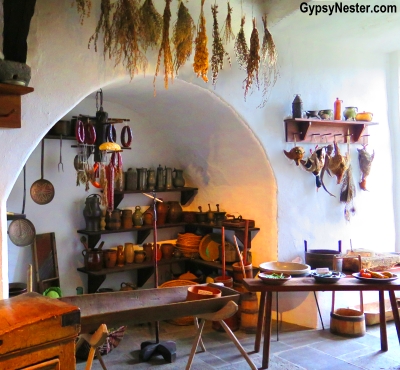
Inside we get to see eight-hundred years of well-preserved history.
The furnishings have been restored through the efforts of the German Castles Association, who bought the castle in 1900.
Although most of the artifacts are from other places, they provide an excellent look into life in the middle ages.
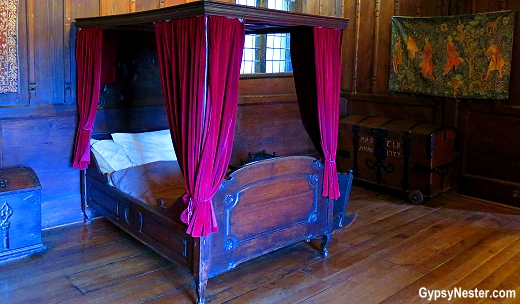
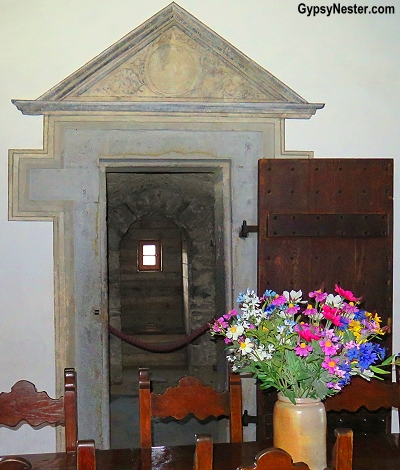
We get a lesson in medieval plumbing in the knights room, where the privy sits right behind the dining table.
The idea was that no knight wanted to miss out on what was being said at dinner simply because nature called.
The next room depicts a timeline of various knights’ uniforms, armors, and weaponry on a series of mannequins. The array of spears, battleaxes, maces, clubs, and other implements of mayhem make the shields and armor look wildly insufficient.
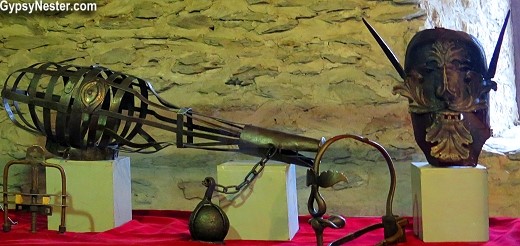
Eye-opening displays of torture, no wait, let’s call them criminal punishment devices, harken back to the days when Marksburg served as a prison. Certainly looks as though harsh sentences were the order of the day back then.

Of course, the view from the castle is spectacular – with the Longship Odin on the water!
Afternoon: Soooooo many castles!
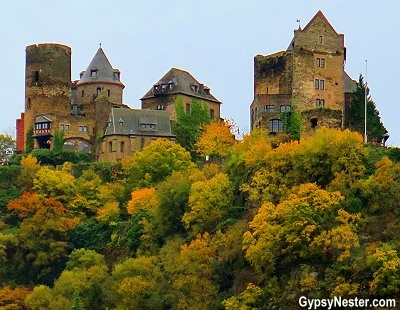
Our afternoon consists of cruising through an unbelievably beautiful onslaught of castles along both sides of the Rhine.
We never travel more than a mile or so before seeing the next fortress.
In fact, it is very possible that we are never out of sight of at least one castle.
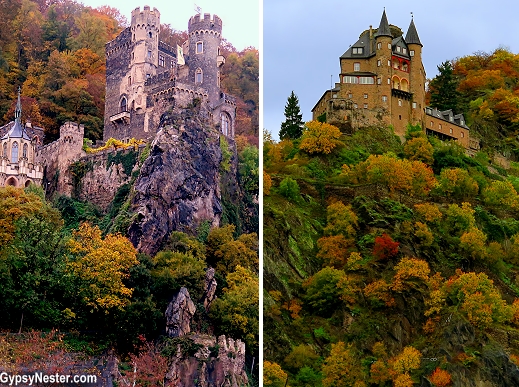
Evening: A taste of Germany (or how David ODs on delicious sausages)
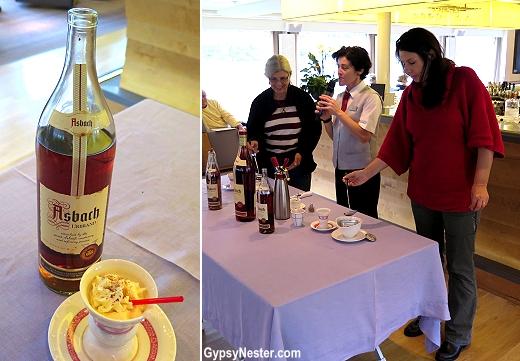
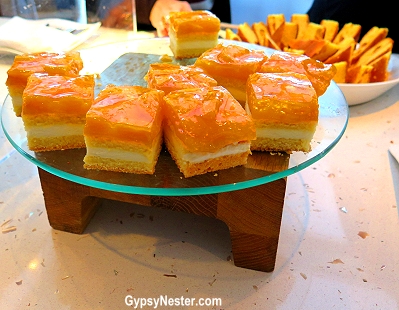
Yummy, local desserts are served with the finished product!
To keep us warm and alert while castle watching, a special Rudesheimer coffee-making demonstration is set up in the lounge.
Veronica volunteers to burn some sugar, and then some Asbach, a brandy made from local reisling grapes.
With whipped cream on top, the finished product perks everyone up for another round of fortress finding.
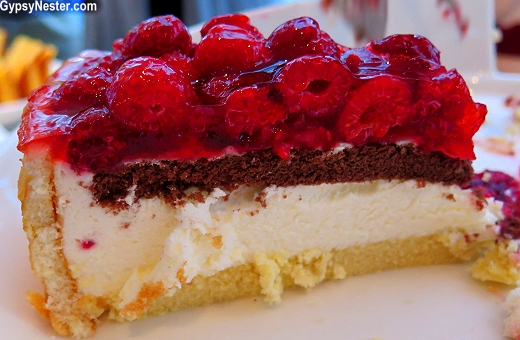
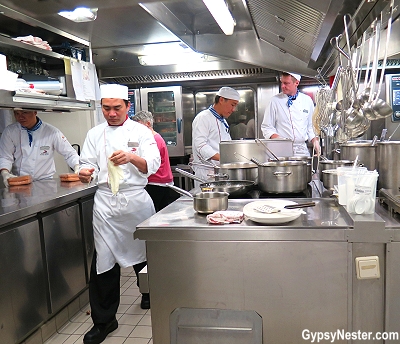
Chef Andreas has prepared a spectacular Taste of Germany for dinner this evening.
A remarkable array of sausages, more sausages, meats, cheeses, dumplings, sauerkraut, sweets and sausages is laid out buffet style through the lounge, the dining room, and even in the galley.
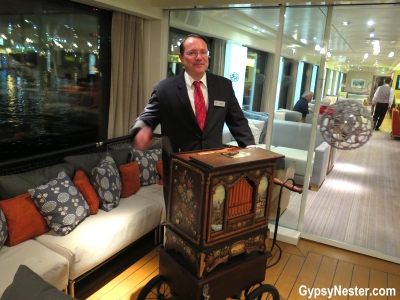
While we are browsing the culinary options, our new friend and hotel manager, Thomas, regales us with some music from a barrel organ.
In doing so, he becomes an organ grinder, as in one who cranks a barrel organ. Unfortunately, (or perhaps very fortunately depending on the point of view) there are no monkeys involved.
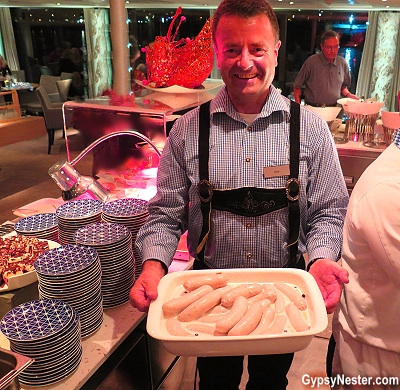
Jose tempts us with just one more sausage!
Turns out that there may well be a limit to just how much sausage a human can consume before becoming comatose.
David found that line after dry pork sausage, hot sausage, beef sausage, veal sausage, and several types of salami, when bed became the only viable option.
We’re not done yet! Continue along with us on our way to Prague!
David & Veronica, GypsyNester.com
Written aboard the Longship Odin on her river voyage with stops in Paris, Luxembourg, Trier, Cochem, Heidelberg, Wurzburg, Rothenburg, Nuremberg, and Prague. Thanks to Viking River Cruises for inviting us along and providing this adventure! As always, all opinions are our own.


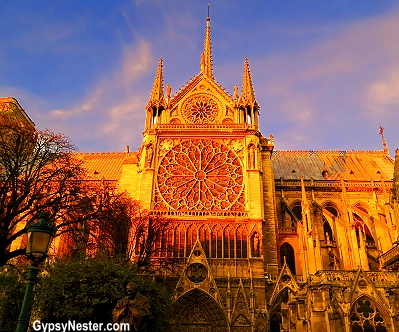
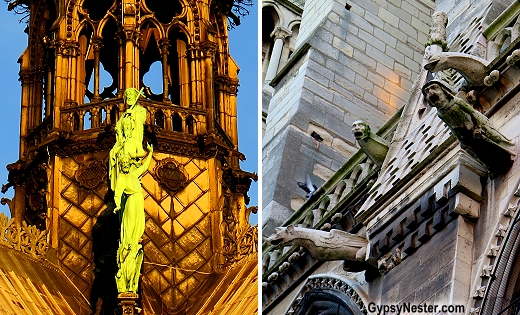
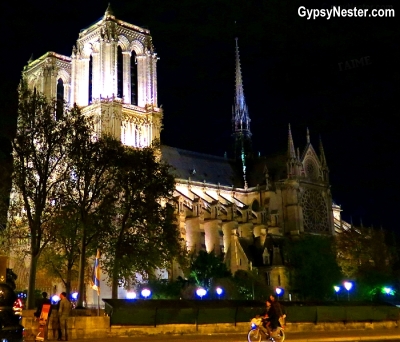
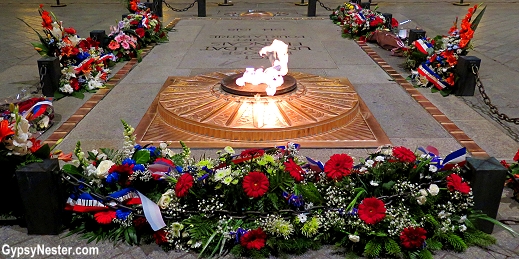
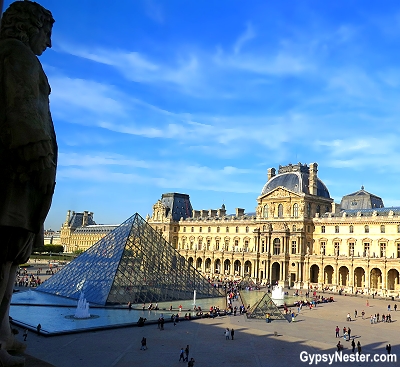
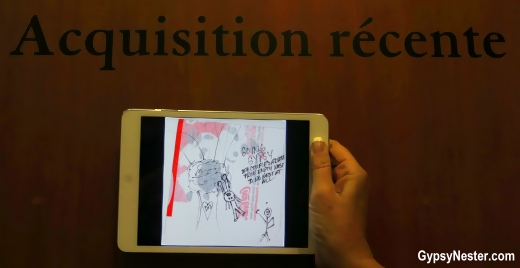
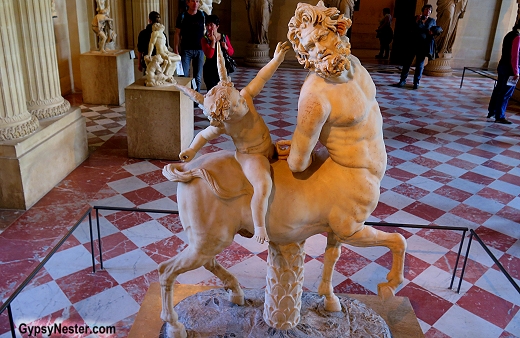
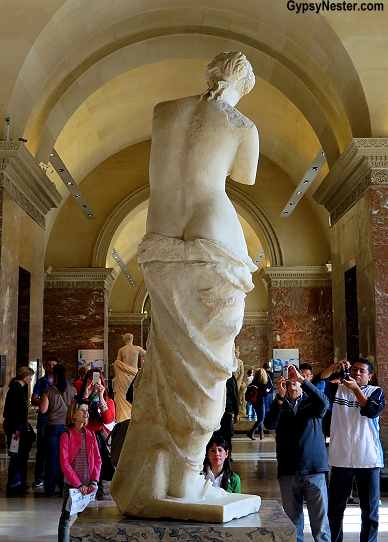
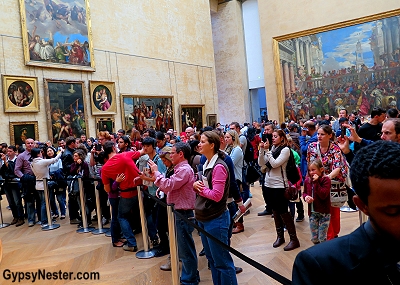
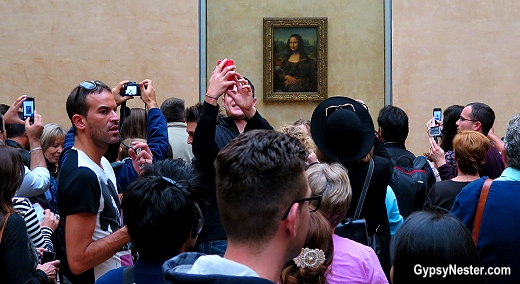
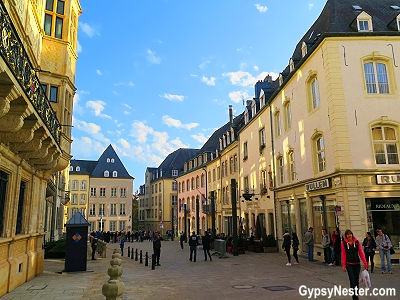
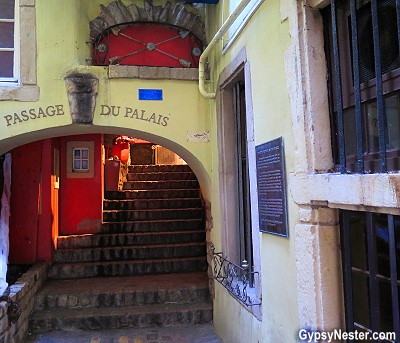
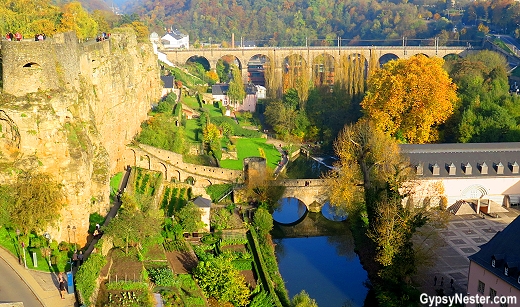
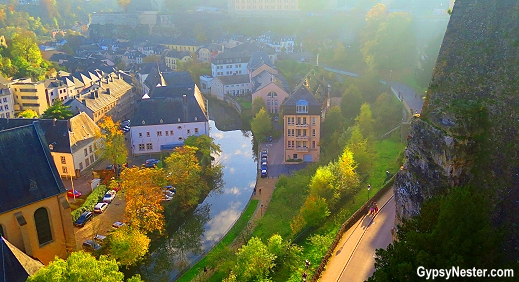
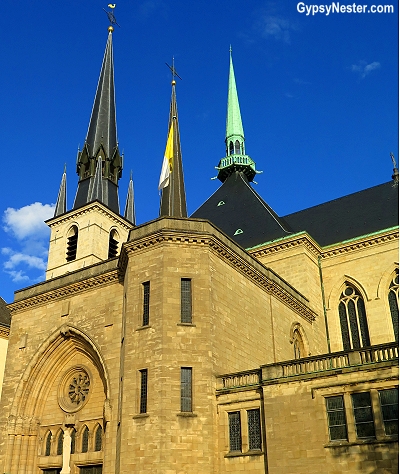
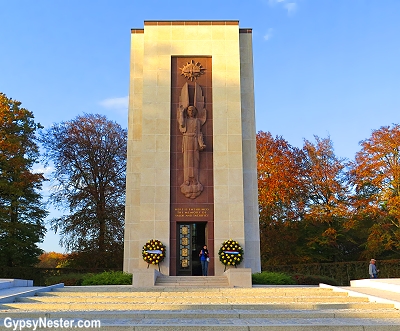
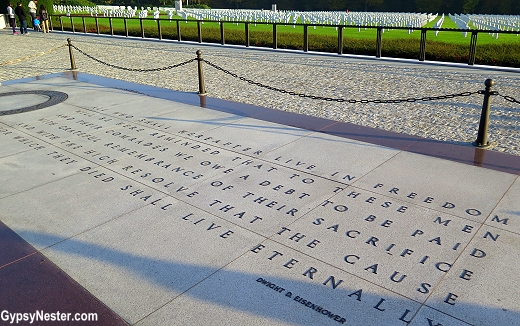
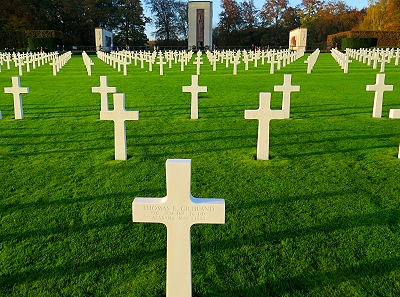
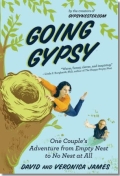
Wow! Great TIPs! I love that article. Thx
God bless gypsys!
excellent website cc shop
brilliant website
brilliant website
The Viking cruises are on of the best ways to discover the hidden treasure of the German,its wine country in the vicinity of the city of Trier
Some people think, that French cars are as good as German wine, and that German wine is as good as French cars.
But it is an understated fact that Germany has the most northern most wine cultivation in Europe. The German wine culture, dates all the way back to the Romans, who introduced it to the Mosel river valley on the border with France and ever since then the Germans have been cultivating wines such as the Riesling grape variety, which is known for being aromatic, fruity and elegant white wine that ranges from very crisp and dry to well-balanced and sweet.
Is it quite an experience having a glass of crispy white Reisling wine, while cruising past the vineyards it made in.
Thank you for the wonderful review of your Viking Cruise! I almost feel like I can cancel my booking! hahaha! We go on the same cruise Sept 15, 2016. I am getting so excited! Did you buy any local wine or liquor at any port and bring it on board? Is that allowed?
We did not so I am not really sure if it is allowed or not. Have a great cruise and safe travels!
Great review. After many ocean cruises, we are set to take this cruise in Oct 2016. Will be rather calm compared to our Round The World trip earlier this year (www.rtw40.com)
Thanks for sharing.
Thanks Gary, would love to do the around the world sometime.
Wonderful blog! We are taking the Citiers of Light cruise this coming November, God-Willing — were you there in the fall too? Any advice re: preparedness for weather / packing suggestions would be appreciated!
Hello Mary! You are in for a big treat! It was November when we went and it got chilly especially at night, but during the day we were comfortable in long sleeves or sweaters. It’s fun to dress smart casual on Viking for dinner, but don’t worry about bringing formal clothes. I try to bring clothes that I can mix and match. But your hotel room comes everywhere with you – and the cabins are great – and for non-cruise days, your luggage is taken from boat to hotel for you by the crew. Have a blast – and if you have any more questions, just ask!
Thank you for the (incredibly)prompt reply — so glad I found your blog — have the book on my list, too! (Both boys in college now!)
That’s great Mary! Be sure to let us know what you think about Going Gypsy – and follow us on Facebook so you can send us some pics of your trip. Can’t wait to see them! – Veronica
As a German living in Trier & working in Luxembourg, it’s always interesting to read about my home town. I grew up in Koblenz and like most people I got used to the beauty of the Moselle valley and the Rhine valley, the castles that string together and the old towns. As a teenager I did not understand why people are fascinated by all this. Today I do. It’s nice to see the places where I live(d) through the eyes of a traveler. Thanks!
Glad to give you our perspective.
Finally I get to read the whole story and both of you are amazing! I have to go through all you stories now as I’m learning so much myself! Wish I had your talent!
Take care both of you!
Greetings from the Czech Republic!
Radim
It was so wonderful to meet you Radim! You are the best Program Director EVER – well done!
Wow! Gorgeous photos! I almost felt like being part of your journey! 🙂
Thanks Renuka!
Haha awesome, the video of the Arc de Triomphe took me back to the first time we were in Paris. Jetlagged and with an 8 hour road trip in front of us, we tried to get out of downtown and probably went around and around for 20 minutes with me screaming, “now, go now, quick, ah too late”. Good times.
That’s pretty much how it was for us too. Luckily, this time we weren’t doing any driving.
WOW! I’m ready to go NOW.
Your photos are like postcards. I love the fairytale feel of the castles. I think we need to go on one of these cruises! Thanks for the lovely virtual tour.
They really are like fairy tale castles! It’s been a amazing trip.
I’ve always wanted to take a Viking River Cruise. Now I want to even more. Coincidentally, I’ve been to all these stops by car, and once even watched a river boat from Reichsburg castle!
It is very cool seeing them from the river.
Thanks for the virtual tour 🙂 Somehow I cannot imagine Marx being happy about what has happened to his former residence. Guess it goes to show that the Germans had no desire to immortalize him…haha
There is just a tiny plaque. Guess he takes the blame for what some people did with his ideas.
I visited Trier many years ago when it wasn’t overrun by tourists 🙂 It also has an old Roman bridge that is in use. It’s a very beautiful and historic city and I have been there many times.
Very interesting city! So much of Rome in Germany was quite surprising.
What a whirlwind of gorgeousness! Such a wonderful way to see favorite places and be introduced to new ones. We’ve not cruised with Viking…yet. Look forward to your impressions.
This is our second time with Viking and they are phenomenal!
So much covered in four days. Amazing. The photos are fantastic. I’d love to take a European river cruise.
Thanks Donna, it’s been great so far!
What a great getaway! The best of all worlds!!
Oh envy, it must be so lovely to go on an extended river cruise and see all these beautiful places float by. I would never go on an ocean cruise, too boring, but any day on a river boat.
We do like the rivers ourselves.
How wonderful to journey through so many different countries along their rivers!
These bones are obviously very strong to be used for support structures and walls. These people were evidently drinking their milk.
This is my dream cruise! Some day!
Should be a good one, Kay. Glad to have you come along with us!
We were invited to cruise with them as well so we could have easily been on the same cruise. Couldn’t make it fit into our busy travel schedule, so they kindly allowed us to take a cruise in the spring but I will be so interested to hear all about your cruise! We have never cruised with Viking but I’m sure it will be fabulous.
Sorry to miss you Jan. We took Viking on the Danube last winter for the Christmas markets and it was wonderful. Have a great cruise!
The Danube and the Christmas Market is the trip I want to take. Unfortunately, I need to find a travel companion.